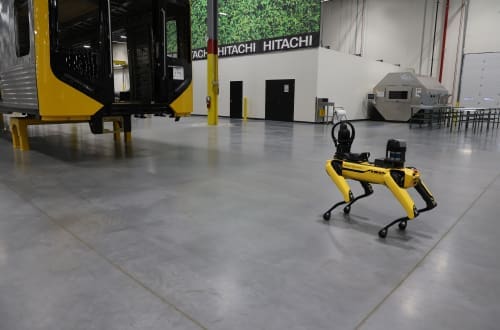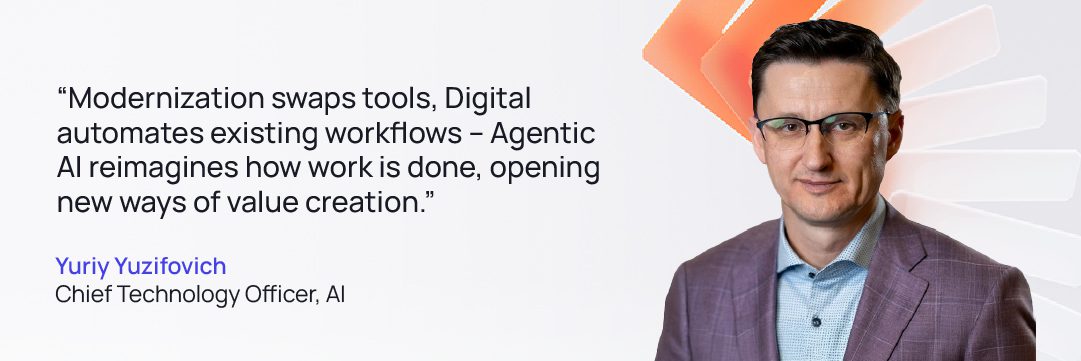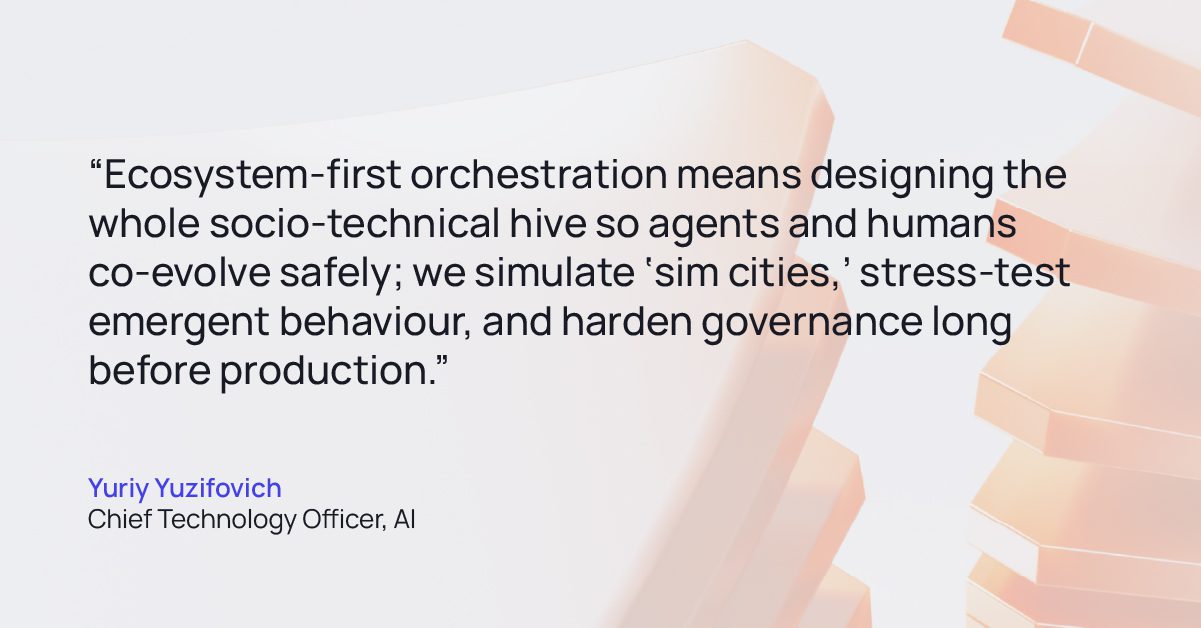- Services
Technology Capabilities
Technology Capabilities- Product Strategy & Experience DesignDefine software-driven value chains, create purposeful interactions, and develop new segments and offerings.
- Digital Business TransformationAdvance your digital transformation journey.
- Intelligence EngineeringLeverage data and AI to transform products, operations, and outcomes.
- Software Product EngineeringCreate high-value products faster with AI-powered and human-driven engineering.
- Technology ModernizationTackle technology modernization with approaches that reduce risk and maximize impact.
- Embedded Engineering & IT/OT TransformationDevelop embedded software and hardware. Build IoT and IT/OT solutions.
- Industries
- GlobalLogic VelocityAI
- Insights
BlogsDecember 16, 2024Gene LeybzonAccelerating Digital Transformation with Structured AI Outputs
This code produces the following output that can be imported into the candidate trackin...
 BlogsOctober 30, 2024Yuriy Yuzifovich
BlogsOctober 30, 2024Yuriy YuzifovichAccelerating Enterprise Value with AI
Discover how financial services integrations are transforming from standalone offerings...

- About Us
Press ReleaseGlobalLogicSeptember 23, 2025Hitachi agrees to acquire German data and AI services firm ...
Strengthening GlobalLogic’s data and consulting capabilities and expanding footprint in...
 Press ReleaseGlobalLogicSeptember 10, 2025
Press ReleaseGlobalLogicSeptember 10, 2025GlobalLogic and Ericsson Deploy Private 5G Network at Hitachi ...
The new infrastructure is the digital backbone of the Hagerstown plant, enhancing effic...

- Careers
Published on November 19, 2025Engineering the Agentic AI Fabric: A New Architecture for Enterprise Scale
ShareRelated Content GlobalLogic17 November 2025
GlobalLogic17 November 2025 GlobalLogic Marketing13 November 2025View All Insights
GlobalLogic Marketing13 November 2025View All Insights Yuriy Yuzifovich11 November 2025Recommended authorsSenior Vice President & Head of EMEAVice President & Consumer Business, Americas GlobalLogicView all authorsVice President, Financial Services & Consumer Business CTO, Americas & UKI
Yuriy Yuzifovich11 November 2025Recommended authorsSenior Vice President & Head of EMEAVice President & Consumer Business, Americas GlobalLogicView all authorsVice President, Financial Services & Consumer Business CTO, Americas & UKILet's start engineering impact together
GlobalLogic provides unique experience and expertise at the intersection of data, design, and engineering.
Get in touchAgentic AIEnterprise AICross-IndustryEvery modern enterprise faces the same architectural inflection point: continue operating workflows as manually coordinated sequences stitched together with emails, scripts, APIs, and dashboards. Or, promote them into governed agentic systems that reason, coordinate, and adapt across environments in real time.
That decision separates organizations patching yesterday’s infrastructure from those building an execution layer designed for resilience, automation, and continuous improvement.
Modernization has long meant upgrading infrastructure: retiring legacy code, moving to cloud, refreshing interfaces. It’s valuable work, but incremental. These efforts improve maintainability, but don’t rewire how systems operate.

Agentic AI goes further. It transforms the enterprise from a mesh of applications into an orchestrated agentic fabric. This fabric is an architectural pattern implemented as a runtime environment that provides essential services — shared memory, policy enforcement, and interoperability — that enable teams of specialized agents to collaborate effectively. Each agent is governed, observable, and designed to operate autonomously within defined policy boundaries.
These agents do not replace humans; they scale human intent. Strategy, ethics, and oversight remain human responsibilities. Agents manage complexity at execution scale, reasoning against goals, adapting to context, and improving over time.
This is not just about faster workflows. It’s about establishing autonomous value loops: agents sense signals, apply policy, act in real time, and feed results back into a shared knowledge base. Each iteration compounds system intelligence under strict guardrails.
Engineered with discipline, agentic ecosystems don’t just reduce latency or cut costs. They change the substrate of enterprise IT. Overhead becomes reusable. Contracts behave like dynamic code. Workflows evolve into platforms that can be scaled, governed, and even monetized.
It’s the foundation for a governed, adaptive execution layer that lets enterprises operate, learn, and evolve in real time.
Why Now
Three forces converge to make agentic transformation not just attractive, but inevitable:
System complexity has outpaced manual orchestration.
Enterprises already span multi-cloud estates, and now every major platform has a powerful but siloed agentic strategy — from hyperscalers like Google Cloud, Azure, and AWS to SaaS leaders like ServiceNow and Salesforce. This forces a critical architectural choice: fully commit to a single vendor’s ecosystem to maximize its deep integrations, or engineer a governed fabric designed for interoperability and control across these environments. We help you navigate this trade-off, ensuring your architecture aligns with your business strategy for every workflow.
AI has crossed from task execution to orchestration.
We’ve moved beyond narrow tools to agentic systems that reason across context, share memory, and coordinate 24×7. While open-source frameworks are excellent for prototyping individual agents, they leave the burden of creating a scalable, observable, and secure runtime to you. We engineer that missing layer, shifting workflows from static sequences into continuously learning agentic systems that are governed and built for evolution.
Business pressure has shifted.
The gains from modernization and digital transformation are leveling off. Efficiency is table stakes. Advantage now comes from orchestrating teams of agents and humans who work together safely across frameworks, with continuous improvement by design. These are not siloed bots. They are governed systems that combine human judgment with machine-scale execution, enabled by open standards and real-time observability.
This is the difference between the automobile and the faster horse. Modernization made the horse stronger and faster. Agentic AI builds the car and the entire road system it runs on.
From Static Scripts to Autonomous Systems: Engineering Real-Time Resilience
Traditional enterprise workflows are deterministic: data flows in, decisions are triggered, and tasks are executed in sequence. While reliable under ideal conditions, these workflows don’t adapt well to change. Exceptions require human intervention, delaying execution and increasing operational overhead.
Agentic systems introduce a new execution model: adaptive value loops that respond continuously to real-time conditions.
Here’s how:
Sense.
This is the agent’s perception layer, where we leverage the full power of traditional AI/ML to process massive volumes of data in real time. Agents ingest high-velocity telemetry from a spectrum of sources, from enterprise applications and software APIs to physical IoT sensors and robotics subsystems. A sophisticated layer of machine learning then distills this multi-domain data into structured signals, separating meaningful events from noise and providing the reasoning core with clean, actionable inputs.
Decide.
For mission-critical workflows where errors are unacceptable, we engineer agents for Reliable AI, going beyond purely generative models. This hybrid approach combines three reasoning modes:
- Generative Interface (LLMs): The LLM acts as the brilliant interface for understanding unstructured data, managing knowledge, and handling complex Human-to-Agent communication.
- Traceable Reasoning Under Uncertainty: For navigating ambiguity, agents employ formal methods to precisely estimate and control for uncertainty. This moves critical decisions from unpredictable LLM sampling to auditable risk management — essential for tasks such as incident triage or supply chain forecasting.
- Logical Reasoning (Verifiable Logic): For non-negotiable rules, a symbolic reasoning core — often using predicate logic and policy language — ensures that enterprise policies and safety protocols are enforced with mathematically verifiable, auditable logic.
Act & Learn.
Actions are executed under runtime guardrails, whether they update a database, trigger a software API, or control a physical actuator. Results from all domains feed back into the system to inform future behavior, improving coordination over the entire cyber-physical landscape.
In this architecture, agents behave like policy-bound microservices: modular, observable, and resilient. Engineers instrument these loops with full-stack telemetry, digital twins, and codified governance, enabling systems to adapt safely and continuously.
Humans remain in control: setting intent, defining constraints, and enforcing oversight. But the orchestration of real-time complexity moves into the agentic runtime where decisions scale, and improvements compound with every loop.
What This Looks Like in Practice
Workflows become reusable systems. Once a workflow is codified as an agentic loop, it evolves from a manual process into a modular service. A compliance pipeline, for example, can be packaged in an Agent-to-Agent (A2A) communication envelope, versioned in Git, monitored through the runtime, and exposed via API, enabling safe reuse across teams or even external partners. What was once operational overhead becomes a product with defined interfaces and SLAs.
CI/CD pipeline becomes resilient by design. Agents continuously observe code commits, simulate edge cases in digital twins, and enforce policy compliance pre-deployment. If regressions or risks are detected, agents trigger automated rollback, minimizing defect leakage and enforcing guardrails before human review is required.
Incident triage shifts from reactive to autonomous. Agents ingest telemetry across applications, infrastructure, and edge environments, correlating anomalies and prioritizing risk. Only high-severity cases are escalated to SREs, reducing MTTR and freeing human engineers to focus on proactive resilience engineering.
Proof It Works
This isn’t theory. As a Hitachi company, our agentic capabilities are forged and battle-tested within one of the world’s most demanding and diverse technology ecosystems. We are an active partner in transforming Hitachi’s global divisions, from heavy industry and energy to digital systems and financial services.
This provides an unparalleled proving ground, infusing our architecture with a legacy of Japanese engineering excellence focused on quality, reliability, and long-term value. Our own internal Multi-Agent System (MAS) is just one expression of this hardened capability:
- Proposal agents generate complex RFP responses using structured memory and domain-specific templates, reducing time-to-first-draft by ~70% and improving consistency across regional delivery teams.
- Observability agents continuously scan logs, cost telemetry, and prompt history across all runtime environments. They flag anomalies in real time, enforce governance policies, and feed insights back into the shared knowledge base, reducing mean-time-to-detection (MTTD) for critical AI governance violations.
- Learning agents personalize training paths, track outcomes, and feed telemetry into the semantic base, compressing certification cycles by 15–20% and surfacing skill gaps proactively.
This deep, internal experience does more than prove our expertise; it generates a powerful library of reusable IP.
The patterns, guardrails, and even foundational agents developed to solve complex industrial and business process challenges for Hitachi directly accelerate and de-risk the transformations we deliver for our clients. Consultants can bring you a strategy; we bring you a strategy built on proven, industrial-grade IP.
Each of these agents operates within a unified runtime with shared identity, observability, and policy enforcement — not as isolated tools.
That’s what makes them production-grade and evolution-ready.
Every agent begins the same way: with a high-friction workflow. It’s simulated inside a digital twin, pressure-tested with edge cases and adversarial prompts, then promoted into production with telemetry and guardrails intact.
We now apply the same runtime, standards, and playbooks to client environments, not just to automate work, but to engineer adaptive systems that improve with every loop.

Early Wins, Engineered for Scale
Agentic AI isn’t a moonshot or a lab experiment. It starts with targeted deployments where complexity, latency, or manual coordination create real engineering drag.
Initial entry points often include:
- Service triage, where agents analyze telemetry and escalate only true exceptions to human teams, compressing response time and reducing noise.
- Project and program visibility, where agents track commitments across teams and flag risks early, offering a shared source of truth without extra coordination overhead.
- Operational planning, where schedules, inventories, and capacity shift in real time, and agents recompute plans faster than humans can refresh spreadsheets.
- Knowledge-heavy reviews, such as compliance, contracts, and quality checks. These are domains where drift, ambiguity, and manual reviews slow everything down.
A word of caution, however: automating a broken process only creates a faster, more expensive broken process. The most sophisticated agentic system can’t deliver value if the human workflows around it remain unchanged. Handing a team the keys to a Formula 1 car is pointless if their roadmap is still a horse trail. This is why our approach is socio-technical. We don’t just engineer the agent; we co-design the new operational models, skills, and processes with your teams to ensure the technology is adopted, trusted, and scaled effectively.
When agents are deployed into these high-friction environments, impact is immediate and measurable: faster cycle times, reduced effort, and better predictability. More importantly, some workflows begin to behave like reusable systems — versioned, observable, and productizable.
Typical early-stage outcomes:
- 20–40% cycle-time reduction in targeted workflows
- 10–15% cost takeout in targeted operating domains
- 1–2 workflows structured as internal products or platforms
But the real inflection point isn’t a performance stat, it’s operational trust. Teams see how agents behave under production-grade constraints, with full telemetry, simulation, and governance in place.
That’s what enables scale: the shift from isolated pilots to a composable, governed system that evolves safely across environments.

Engineering for Trust: Making the Agentic Runtime Observable, Portable, and Safe
Most failed AI deployments don’t fall short because the agents lacked capability. They failed because the architecture wasn’t built for observability, governance, or scale. Agentic AI works only when the full execution environment is engineered with production-grade discipline from day one.
At GlobalLogic, we architect the runtime around five engineering imperatives:
- Strategic Interoperability by Design.
We recognize that the right architecture is a strategic trade-off. Our runtime is engineered to give you control over that choice, allowing you to:
- Maximize Platform Strengths: When speed and deep integration are paramount, we help you build and govern agents that fully leverage a single ecosystem. Our deep partnerships with leaders like Google Cloud, Microsoft Azure, AWS, and ServiceNow, for example, allow us to construct highly optimized, platform-native solutions while wrapping them in the required layers of enterprise observability and safety.
- Engineer for Portability: For core business logic that cannot be locked into a single vendor, we engineer portable agents that run consistently across any environment, preserving your strategic independence.
Our role is to provide the unified governance and runtime layer that allows you to confidently mix these approaches. You can leverage platform-native agents for specific tasks while ensuring your critical end-to-end processes remain portable, observable, and under your control.
- Unified Knowledge Fabric.
Our agents operate from a unified knowledge fabric, a concept that goes well beyond standard Retrieval-Augmented Generation (RAG). At its core is a dynamic Enterprise Knowledge system that represents the complex, multi-hop relationships between your organization’s entities, processes, policies, and data. This fabric, itself agentic, ingests and transforms scattered knowledge from diverse sources — including unstructured manuals, technical diagrams, and structured data from legacy systems — into a coherent, machine-readable model.
Agents leverage this fabric through a hybrid approach:
- Traversal through the structured knowledge base for precise, logical reasoning where relationships are key.
- Semantic Search for handling non-standard requests and open-ended context engineering.
Crucially, this fabric is not static. As agents execute tasks and interact with systems, they continuously maintain and enrich the graph, creating a self-improving loop where the system’s shared context evolves in lockstep with your business. This ensures decisions are not only consistent and auditable but deeply context-aware.
- Guardrails embedded in execution.
Governance isn’t bolted on; it’s expressed as code and enforced in real time across every agent interaction. For critical agents, our Reliable AI architecture codifies core policies using predicate logic, creating mathematically verifiable constraints that cannot be hallucinated or overridden by the generative layer. From access control and security posture to compliance flags and carbon budgeting, policies are enforced as executable constraints inside the runtime.
- Simulated before production.
Every agent is tested in a high-fidelity digital twin. We simulate not just individual agents but the emergent behavior of the entire Multi-Agent System, stress-testing collaborative workflows with edge cases, adversarial prompts, and chaos scenarios before they are promoted to production
- Observability by default.
The runtime instruments every agent with telemetry across performance, cost, and risk — including BYO agents built with third-party or low-code tools. That observability flows into a unified view, giving platform teams full insight without requiring proprietary hooks or rewrites.
Unlike vendors that centralize orchestration in proprietary gateways, we run the agentic runtime wherever your operations are. This means it can be sidecarred into your VPCs, deployed at the edge, or embedded directly within physical systems like industrial robotics, autonomous vehicles, and smart infrastructure. That’s what makes our fabric a true execution layer for both the digital and physical enterprise – powerful, portable, and governable by default.
Engineering the Next Operating Layer, from Pilots to Production
Modernization moved infrastructure to the cloud. Digital transformation improved interfaces and workflows. But Agentic AI reshapes the execution layer of the enterprise itself, turning workflows into systems, policies into real-time guardrails, and applications into interoperating agents that learn, adapt, and evolve.
For technical leaders, the core challenge isn’t proving agent capability but validating safety, interoperability, and governance across the full production landscape: cloud, on-prem, edge, and everything in between. That’s what separates clever agents from scalable systems.
The organizations that move first — building open, governed agentic architectures — won’t just gain efficiency. They’ll define the execution model others have to follow. Those that delay risk fragmentation, lock-in, and runaway technical debt.
The path from AI hype to real-world ROI doesn’t start with a massive, multi-year project. It starts with a 90-minute opportunity workshop with our AI experts.
- Share Proven Patterns for Your Industry: We start by sharing best practices derived from our real-world deployments — distilling what works, what doesn’t, and common pitfalls to avoid — all tailored to the unique challenges of your industry. This helps us quickly identify a high-impact, low-risk starting point.
- Sketch Out the Solution: Together, we’ll sketch a conceptual solution and a high-level agentic workflow for your prioritized opportunity.
- Align on the Validation Path: We’ll align on the target business outcomes and outline a clear, phased path to validate the solution’s impact and feasibility.
Ready to move from exploration to execution? Let’s see if it’s a fit.
 How can I help you?
How can I help you?
Hi there — how can I assist you today?
Explore our services, industries, career opportunities, and more.
Powered by Gemini. GenAI responses may be inaccurate—please verify. By using this chat, you agree to GlobalLogic's Terms of Service and Privacy Policy.
